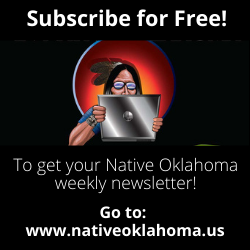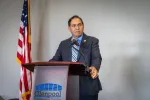

Osage Nation gets approval for the largest fee-to-trust application in Oklahoma history
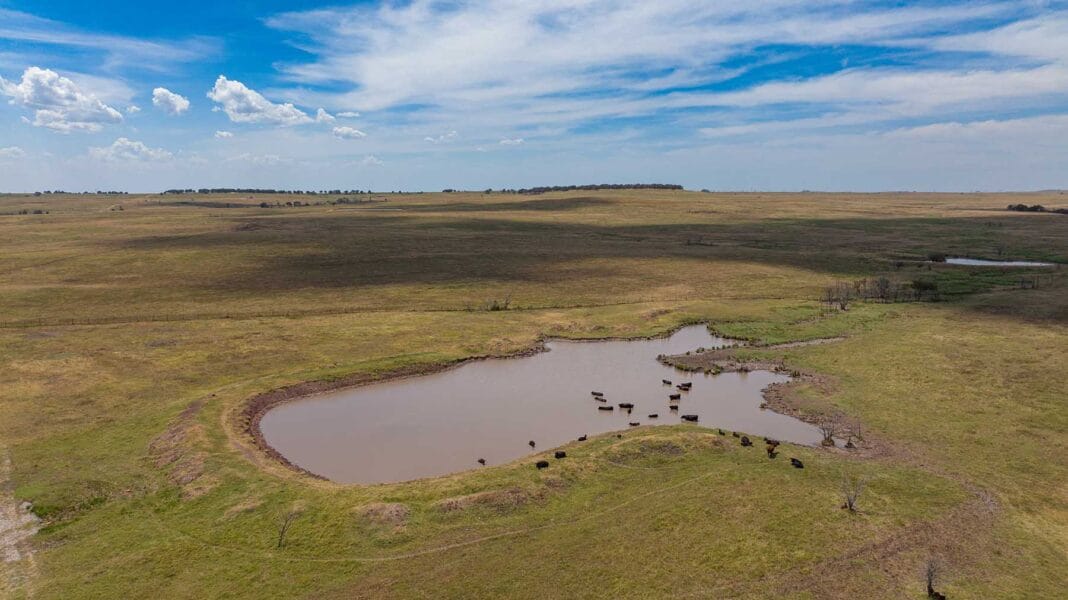
By Anna Pope, KOSU
The Osage Nation’s fee-to-trust application for 41,521 acres is approved. It’s the largest fee-to-trust acquisition in Oklahoma history and the second-largest in U.S. history, according to a press release from the Osage Nation.
The Osage Nation Ranch is the home of hundreds of bison, cattle, grazing land, oil and gas hardware, water features, arbors and is used to share Osage traditions and stories.
Recently, the nation’s fee-to-trust application was approved and Geoffrey Standing Bear, principal chief of the Osage Nation, said this means it has jurisdiction and authority over the land.
“Also, there's pride in knowing that if you're Osage, no matter where you live, you drive through that 1000s of acres,” Standing Bear said. “You own that ranch. You are an owner of this land and the right to it, but through a lot of different turns, a lot of different ups and downs.”
Putting the land into trust, transfers the land title from a federally-recognized Tribe to the U.S., in trust, for the benefit of that Tribe, according to the Bureau of Indian Affairs. Tribal Nations govern trust land and it’s generally not subjected to state laws, but federal restrictions do apply.
The Osage Nation first submitted a fee-to-trust application in 2016 to start the lengthy process. Although in trust lands are common, Standing Bear said this one was a little more complicated.
“I can tell you the size of it made it very tedious to go acre by acre, looking at, particularly the United States is so concerned about environmental damage, as they should have been and should be,” Standing Bear said. “They've had a lot of field work, plus archeological surveys they do all that, etc.”
For Standing Bear, putting land into trust is one of his priorities, along with language and culture preservation. This recent acquisition will not change the use of the land, and he said the nation has other applications processing.
“This is your land, and your children's land, and your grandchildren's land,” Standing Bear said, in a message to other Osage citizens. “And there's no loans on it, and there's no mortgage on it, and that is not going to happen. We're not giving this land up again. We were pushed into that before, but we want to acquire more, and we want to do this again. But land is very expensive.”
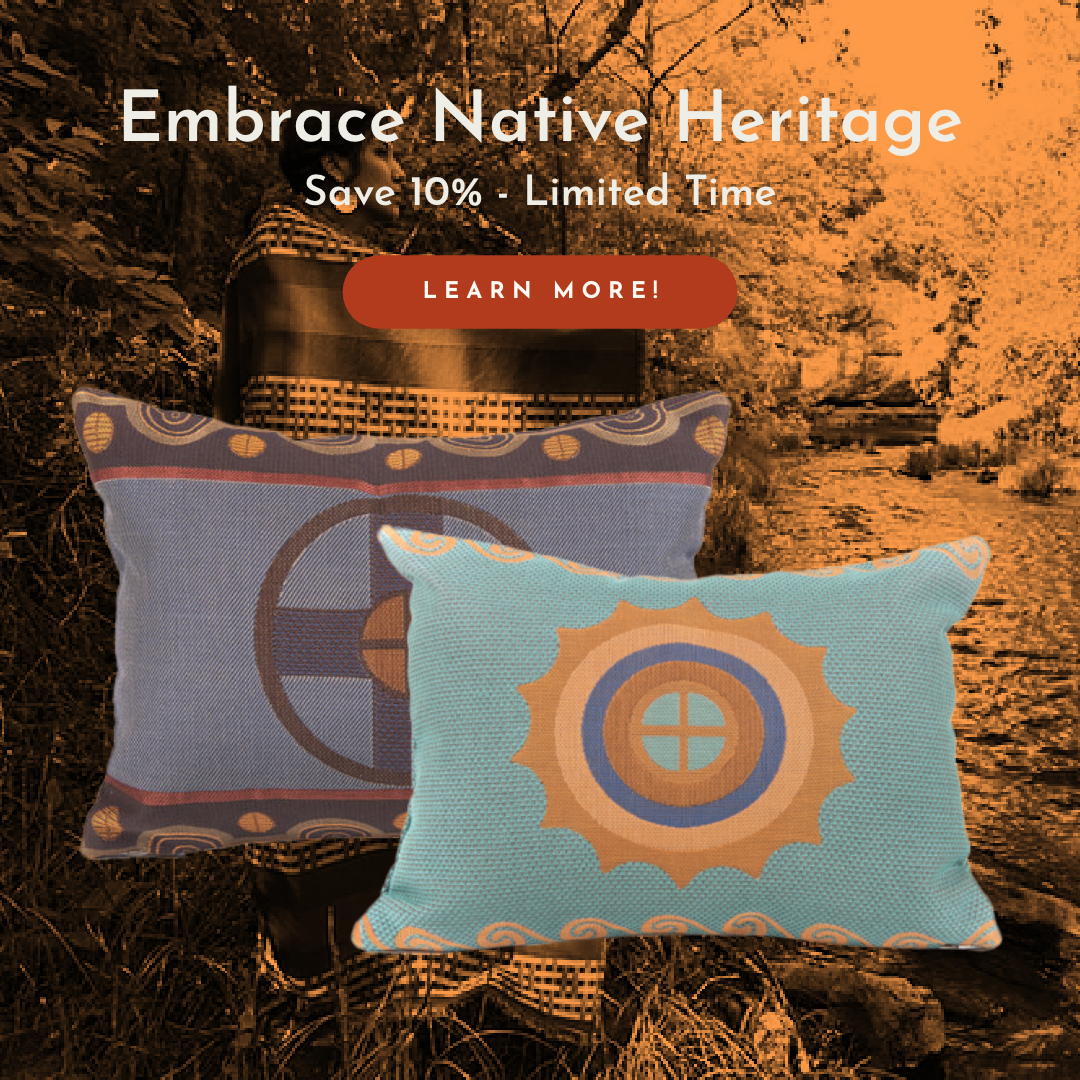
Two Indigenous Nations in Oklahoma to receive funds for orphaned wells
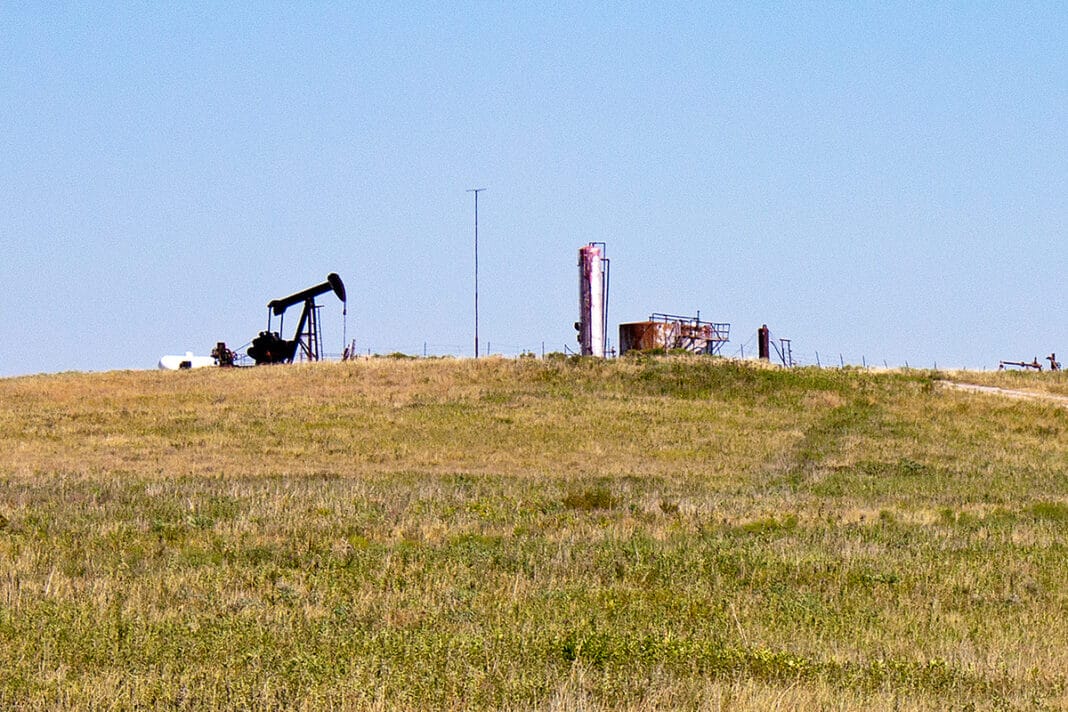
By Kevin Eagleson, Gaylord News
The Biden-Harris administration recently announced over $12 million in grant funding will be distributed to Indigenous nations, including two nations in Oklahoma, to clean up legacy pollution through the Bipartisan Infrastructure law.
As part of phase two of the project to clean up legacy pollution and plug orphaned wells, the Caddo Nation of Oklahoma will receive $3,707,129 in program development and implementation grant funding, and the Osage Nation will receive $1 million in program development grant funding.
According to the Department of Interior, the Caddo Nation of Oklahoma will use the funds to verify and assess up to 20 orphaned wells identified during phase one of the project. Once the wells have been verified and assessed, they will plug the wells and remediate well sites.
The Osage Nation will build on inventory, assessment and plugging activities conducted during phase one of the project and develop remediation plans by documenting environmental degradation, creating map boundaries of contaminated areas and prioritizing well sites with the greatest environmental risk moving forward.
Neither the Caddo Nation of Oklahoma nor the Osage Nation responded to requests for comment prior to publication.
According to the Orphaned Wells Program Office of the Department of Interior, there are at least 17,865 orphaned wells in Oklahoma as of November 2023. The Environmental Defense Fund found that there are more than 81,000 documented orphaned wells across the United States.

A heatmap published by the Environmental Defense Fund shows that most orphaned wells in Oklahoma are located in eastern Oklahoma, particularly northeast Oklahoma.
The fund said that Okmulgee County had the largest number of orphaned wells in the state with 1,637. Nowata, Washington, Creek, Rogers and Key were close behind with total abandoned wells ranging from 1,172 for Key County to 1,472 located in Nowata County.
As of 2022, Oklahoma has begun work to plug 1,196 orphaned wells through funding from the Bipartisan Infrastructure Law.
“State oil and gas regulators intend to work with other state agencies to identify and address tracts in overburdened communities that need to be remediated,” according to the Department of Interior. “Additionally, Oklahoma will collaborate with federally recognized Tribes to plug wells within their historic boundaries.”
Orphaned wells can cause pollution and lead to health risks. Orphaned wells are abandoned oil and gas wells with no known operator or are unable or willing to be plugged.
“Orphaned oil and gas wells have the potential to jeopardize public health and safety by contaminating groundwater, seeping toxic chemicals, polluting drinking water sources, emitting dangerous pollutants and harming wildlife,” a press release by the Department of Interior said. “Methane leaking from many of these unplugged wells is a severe safety hazard and is a significant cause of climate change, being more than 25 times as potent as carbon dioxide at trapping heat in the atmosphere.”
Research by PSE Health Energy found that at least 3 to 6 percent of total methane emissions in the United States are from orphaned oil and gas wells.
“Millions of Americans across the country live within a mile of an orphaned oil and gas well, which are polluting backyards, recreation areas and community spaces across the country,” a 2022 press release by the Department of Interior said.
Through the Bipartisan Infrastructure Law, $4.7 billion was allocated for orphaned well site plugging, remediation and restoration. $4.3 billion is allocated to be used to plug orphaned wells on state and private lands. $250 million will be used to cap orphan wells on public lands. $150 million will be used to cap orphan wells on Tribal lands.
PSE found that, due to inflation and the discovery of previously undocumented orphaned wells, the $4.7 billion Bipartisan Infrastructure Law is not enough. PSE found an additional $1.6 billion to $3.7 billion is needed to plug all orphaned wells in the United States.
In 2022, StateImpact Oklahoma reported that researchers from the University of Oklahoma were awarded $1.7 million by the United States Department of Energy to repurpose orphaned wells to provide geothermal energy.
Research by PSE found that the location of many orphaned wells provides an opportunity to support underground storage of carbon dioxide, hydrogen and natural gas. They also found that plugging and remediating orphaned wells could create a job market for thousands of potential workers.
“The historic investments to clean up these hazardous sites will create good-paying jobs, union jobs, catalyze economic growth and revitalization and reduce dangerous methane leaks,” a 2022 press release by the Department of Interior said.
Kevin Eagleson is reporting from Gaylord News’ Washington bureau this fall as part of an OU Daily scholarship.
Gaylord News is a reporting project of the University of Oklahoma Gaylord College of Journalism and Mass Communication. For more stories by Gaylord News go to GaylordNews.net
Long-awaited Tribal columbarium complete
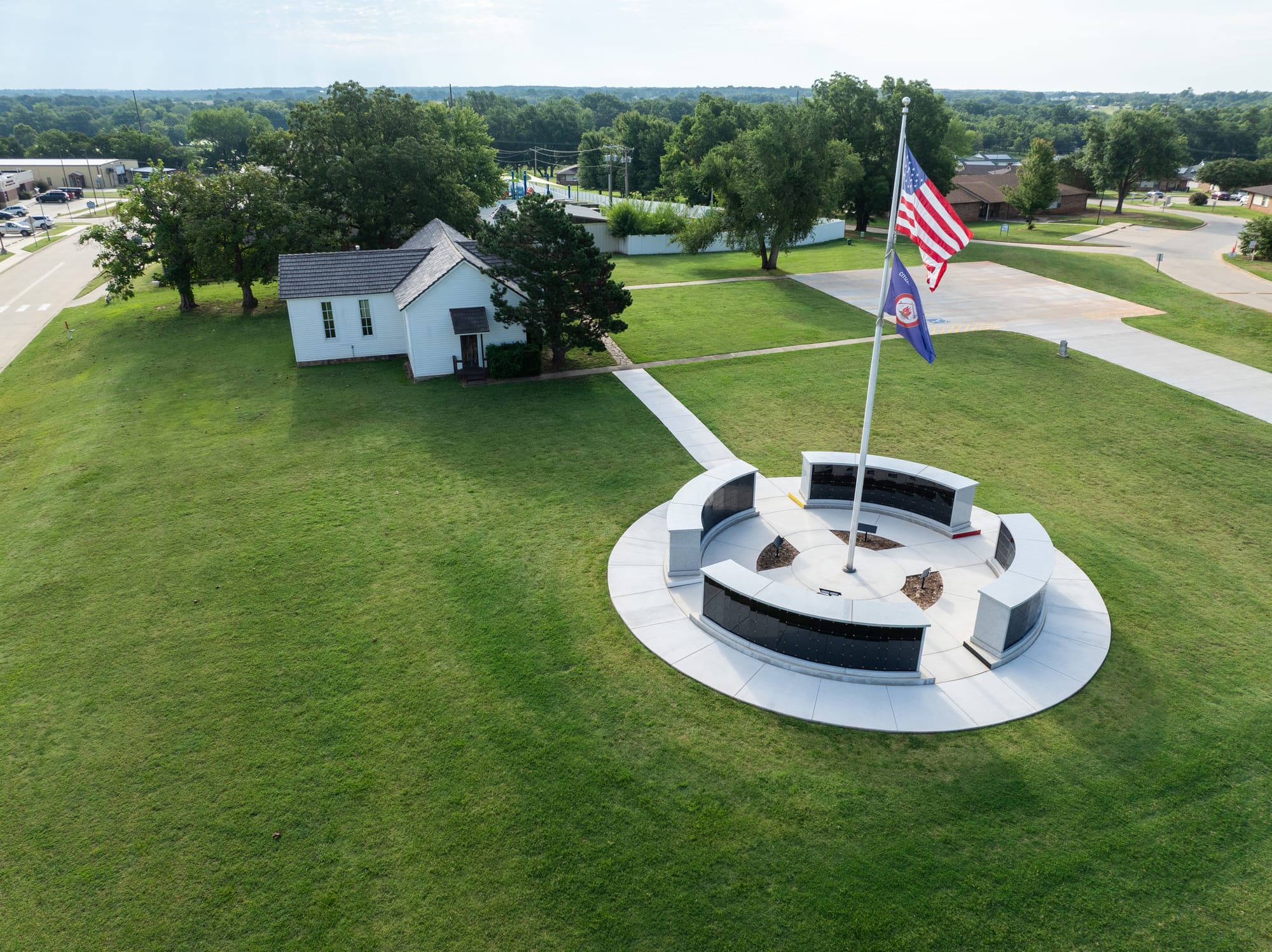
Mary Leaver, Citizen Potawatomi Nation Public Information Department
Construction on the new Citizen Potawatomi Nation Tribal columbarium has been completed, giving Tribal members the option to choose Tribal grounds as their final resting place.
The announcement was made at the 2024 Family Reunion Festival during the Saturday General Council meeting by CPN Chairman John “Rocky” Barrett and Vice-Chairman Linda Capps.
A columbarium is an above-ground structure that holds the remains of individuals who have chosen cremation.
The structure was designed in the shape of a prayer circle and includes the colors of the four directions and invokes the blessings of the seven prayers, Barrett noted.
“We can accommodate traditional Potawatomi services, military services or Christian services. Memorial plaques can even be designed to denote military service,” Barrett said.
Capps said the site includes 400 niches that can each hold up to two sets of ashes. It is located at 4 Dr. Leon Combs Drive, near Shawnee, Oklahoma.
The columbarium, or jibéwgemek, meaning place of spirits, is located next to the former Shawnee Friends Mission church building that was established in the 1870s by Quaker missionaries and is now used for Tribal services.
The current columbarium will likely be full within a short amount of time, Capps said. Experts predict U.S. cremation rates to reach nearly 80 percent by the year 2040.
“We are prepared to possibly add several more (structures) in the space. Many hometown cemeteries are filling up. The columbarium is expected to become more in demand in the future,” Capps said.
Earlier this year, a laser cutting machine was purchased to engrave the granite faceplates of each niche. The faceplates are engraved with the name or names of those who are inurned in that location.
CPN Public Information Director Kent Bush and Senior Graphic Designer Trey DeLonais researched and selected the laser and associated software. DeLonais has been engraving the faceplates and assisting with installation.
“Trey has been such a blessing. He really stepped up to the plate,” Capps told Tribal members at General Council.
Engraving the niches at CPN is more economical, Bush said. The laser is also used for other projects that involve engraving or cutting designs, graphics and text on a wide range of items like granite, wood, fabric and paper.
Completing the engraving in-house will save CPN thousands of dollars annually, Bush added.
Funds for the columbarium’s design and construction were approved in the 2023 Tribal budget. The American Rescue Plan Act was a significant source of funding, Capps said.
Barrett said the Nation will create a permanent fund for the columbarium’s maintenance and upkeep.
Guidelines for applications
A few guidelines have been established for those who wish to apply for a columbarium niche. The application is not intended to reserve a spot for future use but submitted only upon the death of a Tribal member or their loved one.
Completed applications should be submitted to CPN Tribal Rolls, which will verify enrollment. While each niche may hold the cremated remains of up to two urns, at least one applicant must be an enrolled member of CPN.
The niche location will be assigned as the cremated remains are received.
Once the confirmation process is completed, a copy of the application will be provided to CPN Public Information Department for engraving purposes.
Chickasaw artist draws on natural spring of inspiration
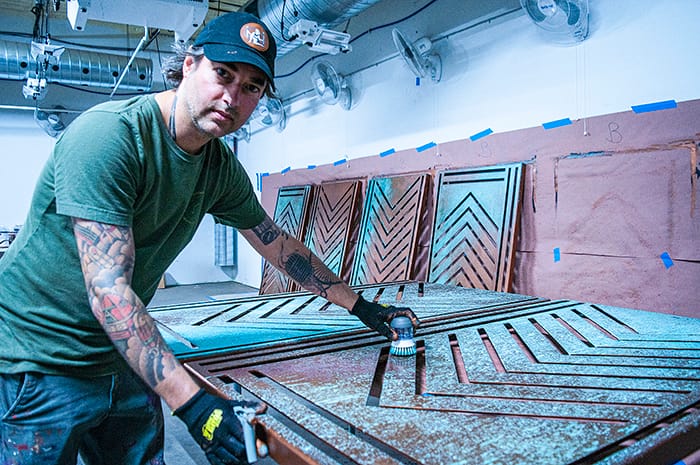
OKLAHOMA CITY – Addison Karl opened a can of chemical, peered into the container, gave it a stir and began working with the cold patina on a copper façade that will soon grace the Chickasaw Nation’s Exhibit C art gallery.
The chemicals were applied to the copper paneling with a brush and then “stippled” with a coarse plastic brush.
It gives it an appearance of aging. The patina was Addison’s proposal, and he was in Oklahoma City giving the treatment to more than 78 panels in an abandoned warehouse on Santa Fe Avenue in a deserted area just north of the Oklahoma Capitol building.
“I came into the mindset of patina and sculpting through the eyes of a painter. What we are doing in Oklahoma City is using a technique I use in sculpting. I am taking the process and making it two dimensional, but it will be three dimensional because the panels will be added to a structure,” Addison said.
Addison ventured to Oklahoma City to embark upon the task he advocated for with Chickasaw Nation officials and performed consulting service and patina application at cost. The global traveler happened to be in the United States to apply chemicals to create the cold patina, and to begin a public art project in Seattle, Washington.
He resides in Italy and has spent most of his adult career in Europe and America, with ongoing international projects. Born in Denver, he grew up in Arizona and devoted much of his early career to commissioned works on buildings, both abroad and many projects in the United States.
He also is promoting his new book “Kulli: A Natural Spring of Artwork, Sculpture, Painting, Drawing, Public Art and Inspiration.” Published in February 2024, Addison has been using it to educate his readers on the importance of imagination, experimenting with artistic techniques, explaining his inspiration and drive to provide talent to public works of art and to attract and interest art gallery and museum curators in taking a look at his impressive portfolio.
At 215 pages and loaded with photographs of his artistic thoughts, finished works and ongoing art, it is a look into the heart of the Chickasaw/Choctaw artist who is blazing a trail internationally and attempting to promote as many other Chickasaw artists to a professional audience and art galleries as he possibly can.
The idea for the book came during an isolation period in Italy where he was tending to his newly born son, Owen Kulli Gava, while his Italian wife, Vera, worked full time as an architect. The family resides in Treviso, approximately 20 miles outside Venice, Italy, one of the most famed cities for critically important ancient and contemporary art in Europe.
“I attempted to write the book colorfully, with lots of photography. I wrote it, edited it, performed the layout design and published it with the idea it could introduce me to art galleries and important public art and museum curators in Europe and the United States,” Addison said.
“It took me about six months to complete from start to finish. I recall I submitted the book to an art gallery in Berlin, Germany. I was told it contained too much writing. I just laughed. The time devoted to it seems like a blur now, as if it happened in just a few moments instead of a few months.”
He is serious about his Chickasaw and Choctaw heritage. His desire to share his art and inspiration exudes from his entire body and being.
“More than mere objects of art, a passionate pursuit to see our stories reflected in the halls of museums and galleries, each a tribute to the historical strides of our convictions,” he writes in “Kulli” to explain his passion to see Chickasaw art and artists succeed and conduct exhibits globally.
He explains his promotional desire by pointing out an April 2024 exhibit by Mississippi Choctaw and Cherokee artist Jeffrey Gibson. Gibson was invited to exhibit works at the Venice Biennale contemporary art show, a premiere Addison attended.
“The most important curators and art patrons in Venice attended. It was an insanely successful exhibition, and he became the first American Indigenous artist to be featured at the show since 1932,” Addison said. “I see that happening with Chickasaw artists in the future. Some have exhibited in Europe and have a growing base of support such as Dustin Mater (painter), Billy Hensley (painter), Brent Greenwood (painter) and Margaret Wheeler (textiles) to name just a few.”
“Kulli” fully embodies all of Addison’s artistic abilities – from spray painting buildings to sculpting and painting. He explains all of his processes and thoughts about creating art honoring Chickasaw heritage, tradition and symbolism.
For a few years now, Addison has entered the Southeastern Art Show and Market (SEASAM) with an elaborate – and expensive – sculpting technique using glass and traditional bronze. The art is quite striking. The technique is called “Lost Wax.”
The resulting hues of turquoise, aquamarine, and slight tinges of green, blue and copper are the result of extreme heat, sand, wax, molten glass and other materials. As he writes in “Kulli,” Addison sees a fluid link between modern art and his ancient Chickasaw heritage.
“Each angle (of the finished product) offers a new interpretation, a dialogue of abstraction, a fresh glyph in the lexicon of glass, inviting a moment to a hushed colloquy with the past,” he writes.
“In the undulating silhouettes, we uncover lineage, a genealogy that threads back to the mound sites of Tennessee, Mississippi and northern Alabama. These mounds … are reliquaries of the Southeastern Woodlands, cradling artifacts that spoke in terminology of shapes and shadows,” he explains in the book. “The (art) is composed of the same earth, air, fire and water that birthed the mounds. It is not merely a sculpture, but a lexicon of history, a murmuring stream that carries the weight of eons.”
“Kulli” is dedicated to his son and Addison bares his soul within the pages and with photography.
Copies of “Kulli” are available at AddisonKarl.com, the First Americans Museum in Oklahoma City at famok.org and Exhibit C in Oklahoma City.
